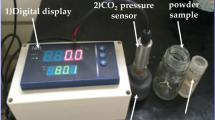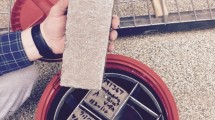Abstract
Fourier transform infrared spectrophotometry (FTIR) was utilized, in order to identify concrete degradation due to biogenic sulfuric acid attack. Concrete samples were exposed to electrolytes containing bio-species in laboratory simulating field conditions and FTIR spectra of the reacted concrete were analyzed for concrete phase formation. The major and minor FTIR absorption bands due to the presence of sulfate were detected in the range of 1200–1100 cm−1 and 650–600 cm−1, respectively. In addition FTIR spectra of the concrete samples exposed to acid-producing microorganisms show an overtone band at around 2350 cm−1 owing to presence of sulfur containing compound in concrete. Results of scanning electron microscopy with energy-dispersive spectrometry complemented and confirmed FTIR analysis.








Similar content being viewed by others
References
Zhang Minghua et al (2013) Study on the expansion of concrete under attack of sulfate and sulfate–chloride ions. Constr Build Mater 39:26–32
Idiart Andrés E et al (2011) Chemo-mechanical analysis of concrete cracking and degradation due to external sulfate attack: a meso-scale model. Cem Concr Compos 33:411–423
Parker C (1945) The corrosion of concrete. Isolation of a species of bacterium associated with the corrosion of concrete exposed to atmospheres containing hydrogen sulphide. Aust J Exp Biol Med Sci 23(3):14–17
Derangere D, Cochet C (1991) Concrete corrosion in individual septic tank systems. Eur Water Pollut Control 1(6):24–28
Attal A, Brigodiot M, Camacho P, Manem J (1992) Biological mechanisms of H2S formation in sewer pipes. Water Sci Technol 26:907–914
Sand W, Dumas T, Marcdargent S (1992) Tests for biogenic sulfuric acid corrosion in a simulation chamber confirm the on site performance of calcium aluminate based concretes in sewages. International symposium on microbiologically influenced corrosion (MIC) testing. November 16–17, Miami, FL, p 21
De Belie N et al (2004) Experimental research and prediction of the effect of chemical and biogenic sulfuric acid on different types of commercially produced concrete sewer pipes. Cem Concr Res 34:2223–2236
Cwalina B (2008) Biodegradation of concrete, Architecture, Civil Engineering. Environment (ACEE) 4:133–140
Monteny J et al (2000) Chemical, microbiological, and in situ test methods for biogenic sulfuric acid corrosion of concrete. Cem Concr Res 30:623–634
De Muynck W et al (2009) Effectiveness of admixtures, surface treatments and antimicrobial compounds against biogenic sulfuric acid corrosion of concrete. Cem Concr Compos 31:163–170
Okabe S, Odagiri M, Ito T, Satoh H (2007) Succession of sulfur-oxidizing bacteria in the microbial community on corroding concrete in sewer systems. Appl Environ Microbiol 73(3):971–980
Islander RL, Devinny JS, Mansfeld F, Postyn A, Shih H (1991) Microbial ecology of crown corrosion in sewers. J Environ Eng 6:751–770
Mori T, Koga M, Hikosaka Y, Nonaka T, Mishina F, Sakai Y et al (1991) Microbial corrosion of concrete sewer pipes, H2S production from sediments and determination of corrosion rate. Water Sci Technol 23:1275–1282
Heuer JJMB, Kaskens HJ (1993) Prevention of concrete corrosion and odour annoyance with biofiltration. Water Sci 27:207–218
Hernandez MA, Marchand E, Roberts D, Peccia J (2002) In situ assessment of active Thiobacillus species in corroding concrete sewers using fluorescent RNA probes. Int Biodeterior Biodegrad 49(4):271–276
Vincke Elke et al (2002) Influence of polymer addition on biogenic sulfuric acid attack of concrete. Int Biodeterior Biodegrad 49:283–292
Monteny J et al (2001) Chemical and microbiological tests to simulate sulfuric acid corrosion of polymer-modified concrete. Cem Concr Res 31:1359–1365
Beeldens A et al (2001) Resistance to biogenic sulfuric acid corrosion of polymer-modified mortars. Cem Concr Compos 33:47–56
Zhang L et al (2008) Chemical and biological technologies for hydrogen sulfide emission control in sewer systems: a review. Water Res 42:1–12
Eštokova A (2012) Study of the deterioration of concrete influenced by biogenic sulphate attack. Procedia Eng 42:1731–1738
Satoh H (2009) Microbial community structures and in situ sulfate-reducing and sulfur-oxidizing activities in biofilms developed on mortar specimens in a corroded sewer system. Water Res 43:4729–4739
De Windt L, Devillers P (2010) Modeling the degradation of Portland cement pastes by biogenic organic acids. Cem Concr Res 40:1165–1174
Bohm M et al (1998) On a moving-boundary system modeling corrosion in sewer pipes. Appl Math Comput 92:247–269
Gutiérrez-Padilla MGD et al (2010) Biogenic sulfuric acid attack on different types of commercially produced concrete sewer pipes. Cem Concr Res 40:293–301
Brundle R, Evans C, Wilson S (1992) Encyclopedia of materials characterization. Butterworth–Heinemann, Oxford, ISBN 0–7506-9168-9
Mollah MYA et al (2000) A Fourier transform infrared spectroscopic investigation of the early hydration of Portland cement and the influence of sodium lignosulfonate. Cem Concr Res 30:267–273
Hughes TL et al (1995) Determining cement composition by Fourier transform infrared spectroscopy. Adv Cem Based Mater 2:91–104
Ghosh SN, Handoo SK (1980) Infrared and Raman spectral studies in cement and concrete. Cem Concr Res 10:771–778
Kloprogge JT et al (2002) Vibrational spectroscopic study of syngenite formed during the treatment of liquid manure with sulphuric acid. Vib Spectrosc 28:209–221
Mollah MYA, Kesmez M, Cocke DL (2003) An X-ray diffraction (XRD) and Fourier transform infrared spectroscopic (FT-IR) investigation of the long-term effect on the solidification/stabilization (S/S) of arsenic(V) in Portland cement type-V. Sci Total Environ 325:255–262
Trezza MA, Lavat AE (2001) Analysis of the system 3CaO·Al2O3–CaSO4·2H2O–CaCO3– H2O by FT-IR spectroscopy. Cem Concr Res 31:869–872
Péra J, Husson S, Guilhot B (1999) Influence of finely ground limestone on cement hydration. Cement Concr Compos 21:99–105
Yu P et al (1999) Structure of calcium silicate hydrate (C-S-H): near-, mid-, and far-infrared spectroscopy. J Am Ceram Soc 82(3):742–748
Vazquez-Moreno T, Blanco-Varela MT (1981) Table of infrared frequencies and absorption spectra of compound related to cement chemistry. Materiales de Construccion 182:31–48
Richard T et al (2006) Diffuse reflectance infrared Fourier transform spectroscopy as a tool to characterize water in adsorption/confinement situation. J Colloid Interface Sci 304:125–136
Ylmen Rikard et al (2009) Early hydration and setting of Portland cement monitored by IR, SEM and Vicat techniques. Cem Concr Res 39:433–439
Vermeij EJ et al (2012) Analysis of microtraces in invasive traumas using SEM/EDS. Forensic Sci Int 214:96–104
Marusin SL (1995) Sample preparation-the key to SEM studies of failed concrete. Cem Concr Compos 17:311–318
Author information
Authors and Affiliations
Corresponding author
Rights and permissions
About this article
Cite this article
Nasrazadani, S., Eghtesad, R., Sudoi, E. et al. Application of Fourier transform infrared spectroscopy to study concrete degradation induced by biogenic sulfuric acid. Mater Struct 49, 2025–2034 (2016). https://doi.org/10.1617/s11527-015-0631-5
Received:
Accepted:
Published:
Issue Date:
DOI: https://doi.org/10.1617/s11527-015-0631-5




